I am getting the peak frequency from wav files
My code for getting the peak frequency from a wav file is:
import wave
import struct
import numpy as np
import wave
import contextlib
if __name__ == '__main__':
fname = "test.wav"
frate = 0
data_size = 0
with contextlib.closing(wave.open(fname,'r')) as f:
frate = f.getframerate()
data_size = f.getnframes()
wav_file = wave.open(fname, 'r')
data = wav_file.readframes(data_size)
data_size = data_size * wav_file.getnchannels()
print wav_file.getparams()
wav_file.close()
data = struct.unpack('{n}h'.format(n=data_size), data)
data = np.array(data)
w = np.fft.fft(data)
freqs = np.fft.fftfreq(len(w))
print(freqs.min(), freqs.max())
# Find the peak in the coefficients
idx = np.argmax(np.abs(w))
freq = freqs[idx]
freq_in_hertz = abs(freq * frate)
print(freq_in_hertz)
I recorded a wav file with 48000 sample rate, 16 bitwidth, 2 channels. In that file I have a sine tone with 1000Hz. But the script outputting only 500Hz. I dont know where I went wrong. But for single channel and generated wav file with 48000 sample rate, 16 bitwidth, 2 channels it is working fine.
I generated the wav file using the following script
import math
import wave
import struct
if __name__ == '__main__':
# http://stackoverflow.com/questions/3637350/how-to-write-stereo-wav-files-in-python
# http://www.sonicspot.com/guide/wavefiles.html
freq = 1000
data_size = 454656 * 2
fname = "test.wav"
frate = 48000.0
amp = 64000.0
nchannels = 2
sampwidth = 2
framerate = int(frate)
nframes = data_size
comptype = "NONE"
compname = "not compressed"
data = [math.sin(2 * math.pi * freq * (x / frate))
for x in range(data_size)]
wav_file = wave.open(fname, 'w')
wav_file.setparams(
(nchannels, sampwidth, framerate, nframes, comptype, compname))
for v in data:
wav_file.writeframes(struct.pack('h', int(v * amp / 2)))
wav_file.close()
I dont know where I did wrong. I uploaded my wav files at script generated wav script_gen.wav with 48000 sample rate, 2 channels, 16 bit. Recorded wavs: 2 channel wav with 48000 sample rate, 2 channels, 16 bit 1 channel wav(Not allowing to post the link here, so will post in the comments) with 48000 sample rate, 1 channel, 16 bit.
I checked all these peak frequency in audacity, it showing 1000Khz only.
But when I tried with my scirpt I am getting correct output for 1 channel wav and failing for 2 channel wav.
update: I am getting the half of the peak frequency as the output for 2 channels.
I am feeling that I missed something. Can anyone help me in this?
